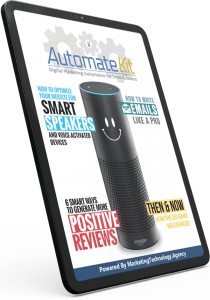We grasp one new reality – like the importance of local search – and another one pops up right behind it.
It can feel impossible to keep up – and yet keep up we must.
What SEO Used to Be
 When studying the evolution of anything, it’s good to start by examining – at least briefly – what used to be. In the world of SEO, that’s a relatively short timeline, but one that’s jam-packed with updates, changes, and rethinking.
When studying the evolution of anything, it’s good to start by examining – at least briefly – what used to be. In the world of SEO, that’s a relatively short timeline, but one that’s jam-packed with updates, changes, and rethinking.
In the earliest days of SEO, search was all about keywords. Webmasters would stuff their pages with keywords confident in the knowledge that this practice would pop their sites up to the top of any search engine’s results page.
Then Google arrived and turned search upside down. Their refined algorithms prioritized quality over keyword stuffing. Suddenly, SEO pros were talking about backlinks and content and things like that…
… And then the algorithms changed again.
Local search became a thing – and then mobile searches surpassed desktop searches and Mobilegeddon happened.
Now, SEO pros have been hit with a slew of new search options.
Five New Search Trends to Remember
 SEO isn’t just for Google anymore – or for Bing and Yahoo.
SEO isn’t just for Google anymore – or for Bing and Yahoo.
In fact, most of the big changes in SEO today are not search engine related, or at least, they’re not related to the search engines we’re used to.
S.E.O. still stands for Search Engine Optimization, but new search options and technology require new kinds of optimization.
This is what you need to know.
Mobile Search
First up is mobile search. If you’re thinking, “Wait, Mobilegeddon happened already! Why do I need to worry about mobile search?” then pay attention – because things have changed.
When we worry about mobile search now, we’re not talking about using Google on your phone. In fact, mobile searches in that sense have become so commonplace that they’re hardly worth mentioning. In the US, more than 70% of all internet usage happens on phones!
Here’s the thing though – most of the time we spend online on our phones isn’t on traditional search engines like Google. We’re actually spending 92% of our time on mobile apps – and that poses a real SEO challenge.
Originally, the only option available for in-apps searches was Spotlight. Now, there are many options – and while some were originally designed to work only for GPS, they have expanded beyond that to general geographical searches.
Google Maps plays a role in many mobile searches too, and it makes sense given how much information is included in a single Google Maps listing.
Voice Search and Personal Assistants
Just a few years ago, speech-to-text technology was uncommon. It existed, but it wasn’t something that people turned to when they wanted to search for something online.
Now, the widespread use of digital assistants like Siri (the iPhone assistant) or Alexa (Amazon’s entry in the market) has brought a whole new facet to the world of search – and to SEO. And it’s not just digital assistants – televisions, lights, and other household items are all connected through the internet of things.
What does this mean for search? Well, for starters, Alexa doesn’t even require the use of keywords to give users what they want. A casual, “Where should I eat tonight?” is enough to get a list of local restaurants. These digital assistants are smart enough to see beyond normal human speech and understand what’s being asked without keywords.
Originally, the only option available for in-apps searches was Spotlight. Now, there are many options – and while some were originally designed to work only for GPS, they have expanded beyond that to general geographical searches.
These new search options expand search beyond our devices. Activated with the sound of our voices, they can take our personal histories and past actions into account to give us the answers to our search inquiries.
Social Search
Another big change in SEO is the way people use social networking sites like Facebook, Twitter, and Instagram to look for content. When these sites were launched, their search functions were basic – intended only to help users find their friends.
 Today, though, more people are using social search engines to find local businesses and services. They know that if they type local search words into Facebook, for example, they’ll get a list of companies whose pages they can peruse.
Today, though, more people are using social search engines to find local businesses and services. They know that if they type local search words into Facebook, for example, they’ll get a list of companies whose pages they can peruse.
There’s also been a switch in that it’s now very easy to use social search to find content instead of brands. If you log on to Instagram, you’ll notice that their algorithms give you recommendations based on your activity on the site. If you view a lot of wildlife photos or take frequent trips to San Francisco, you’ll see those preferences reflected in the content that Instagram recommends to you.
Using the right hashtags and descriptions can help algorithms recommend your content to the people who are most likely to patronize your business.
Messenger Apps
Messenger apps like Facebook Messenger are also playing a role in search. In fact, if you’ve used Messenger recently you’ve probably noticed that if you use certain words – like “song” for example – you’ll get a message that says, “Find songs now.” In other words, there’s a built-in search engine working behind the scenes.
There are messenger apps like Pegg, which provides financial services to small business and start-ups – and some companies are now using messenger bots to handle routine customer service questions.
This is yet another example of casual, non-keyword speech being used to deliver search results in the moment. And it shows that anybody clinging to the old, keyword-centric SEO of the past is missing the boat.
Topic Clusters
Finally, we have the issue of topic clusters – a natural outcropping of the move away from traditional keywords and toward casual and contextual search results based on natural language.
Topic clusters require companies to link pages of related topics together to provide context and meaning for your content. Instead of being forced to write repetitive blog posts, you create a pillar post around one topic and then create other posts and pages that link to it (and from it) to build your site’s architecture.
If you do it properly, the result is a website that is specifically built to recognize a user’s intent and provide them with the means to jump from one related topic to another. It can boost your search engine visibility and ultimately, help grow your business.
Don’t Let the Changing Face of SEO Intimidate You…

These changes are good because they represent an opportunity to move away from optimizing for broken phrases and awkward keywords and into a future where human speech and intent are recognized by search engines without keywords. With any luck, these trends will usher in a new era of content that’s designed to help users and companies connect.











